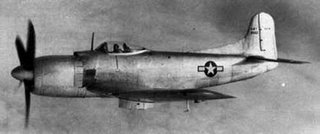Flightdeck Friday: The AM-1 Mauler

Today — the Martin AM-1 Mauler:
 tight flight decks, but expand the range and amount of ordnance to be carried. Several manufacturers were assigned development, but two principals emerged – Douglas with the XBT2D-1 (designed by Ed Heinemann) and the Martin XBTM-1. The Martin entry utilized the experimental Pratt & Whitney XR-4360 radial which generated close to 3,000 hp.
tight flight decks, but expand the range and amount of ordnance to be carried. Several manufacturers were assigned development, but two principals emerged – Douglas with the XBT2D-1 (designed by Ed Heinemann) and the Martin XBTM-1. The Martin entry utilized the experimental Pratt & Whitney XR-4360 radial which generated close to 3,000 hp.
 experimental/developmental equipment. The size of the engine and aircraft was such that it was difficult to fly, especially in the CV-environment. This mandated the development of a complicated hydraulic boost system (which all of us who’ve flown and maintained *know* never leak…) and off-setting of the engine mount by 2-degrees to account for the massive torque of the R-4360. Additional work was required on the prop spinner, wing and tail. Eventually, a re-designed AM-1 entered the fleet in 1947, but in reduced numbers as production was substantially cut following the end of the war. It was also facing the AD-1 Skyraider which grew from the ABT2D following an extensive Heinemann re-design effort (he hated the original Navy mandated-design).
experimental/developmental equipment. The size of the engine and aircraft was such that it was difficult to fly, especially in the CV-environment. This mandated the development of a complicated hydraulic boost system (which all of us who’ve flown and maintained *know* never leak…) and off-setting of the engine mount by 2-degrees to account for the massive torque of the R-4360. Additional work was required on the prop spinner, wing and tail. Eventually, a re-designed AM-1 entered the fleet in 1947, but in reduced numbers as production was substantially cut following the end of the war. It was also facing the AD-1 Skyraider which grew from the ABT2D following an extensive Heinemann re-design effort (he hated the original Navy mandated-design).
 Joining the fleet in 1948, the AM-1, at first labeled “Able Mabel”, quickly made a name for itself –and it was less than complimentary. The “Awful Monster” still had troubles in the CV-environment with an unfortunate tendency to violently vibrate in the tail section following a trap. Of course, this was less than desirable for a carrier-based aircraft and in spite of a tailhook redesign to resolve this issue, more time was lost in terms of fleet acceptance and in growing competition from the AD-1. By all accounts, the Mauler lost points to the Skyraider in the air and on the deck. One maintainer allowed as how it took three days just to change the 56 spark plugs – one day each to remove the cowl and complicated ducts and replace them and another day just to swap out the plugs. The complicated wheel retraction system frequently failed, leading at one point to 6 belly landings in 4 months at NAS Jax. Then too, there remained the ever-present pool of hydraulic fluid underneath the aircraft.
Joining the fleet in 1948, the AM-1, at first labeled “Able Mabel”, quickly made a name for itself –and it was less than complimentary. The “Awful Monster” still had troubles in the CV-environment with an unfortunate tendency to violently vibrate in the tail section following a trap. Of course, this was less than desirable for a carrier-based aircraft and in spite of a tailhook redesign to resolve this issue, more time was lost in terms of fleet acceptance and in growing competition from the AD-1. By all accounts, the Mauler lost points to the Skyraider in the air and on the deck. One maintainer allowed as how it took three days just to change the 56 spark plugs – one day each to remove the cowl and complicated ducts and replace them and another day just to swap out the plugs. The complicated wheel retraction system frequently failed, leading at one point to 6 belly landings in 4 months at NAS Jax. Then too, there remained the ever-present pool of hydraulic fluid underneath the aircraft.
 barn door dive brakes, one comparing it to hanging from a maneuverable parasol in a dive whichsignificantly improved bombing accuracy. The AM-1 was a big, heavy aircraft and in spite of the larger engine, could barely get airborne in a deck run with 28 knots of wind over the deck and no load. The AD-1, on the other hand, could take a 3,000 lb load on a 330 ft deck run under similar conditions.
barn door dive brakes, one comparing it to hanging from a maneuverable parasol in a dive whichsignificantly improved bombing accuracy. The AM-1 was a big, heavy aircraft and in spite of the larger engine, could barely get airborne in a deck run with 28 knots of wind over the deck and no load. The AD-1, on the other hand, could take a 3,000 lb load on a 330 ft deck run under similar conditions.
 By 1950 the Mauler was removed from Fleet service and passed to the Reserves which used them until 1953. Eighteen were converted to electronic counter-measures aircraft, but this too was short lived as the Skyraider proved more capable at this and other mods for Fleet missions. Today a small handful
By 1950 the Mauler was removed from Fleet service and passed to the Reserves which used them until 1953. Eighteen were converted to electronic counter-measures aircraft, but this too was short lived as the Skyraider proved more capable at this and other mods for Fleet missions. Today a small handful still exists and maybe found at the National Museum of Naval Aviation in Pensacola and the former NAS Tillamook in western Oregon.
still exists and maybe found at the National Museum of Naval Aviation in Pensacola and the former NAS Tillamook in western Oregon.


